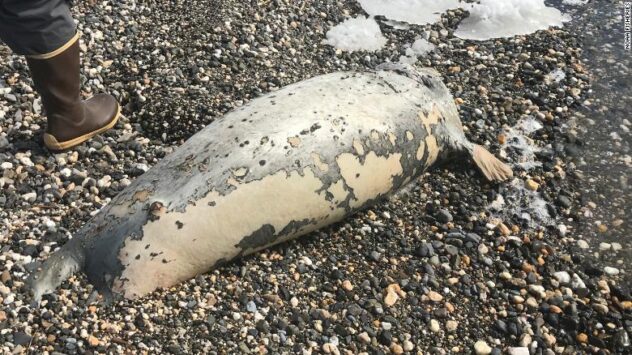
A dead seal found on a beach near Kotzebue, Alaska
©Raime Fronstin/NPS/NOAA Fisheries
Pre-reading questions:
- How is the temperature in your country?
- Is your country rich in bodies of water? Kindly share something about it.
Vocabulary:
- specialist /SPESH-uh-list/
- commercial /kuh-MUR-shuhl/
- sustained /suh-STEYND/
- depend on /dih-PEND-on/
- pattern /PAT-ern/
[noun] – someone who has a lot of experience, knowledge, or skill in a particular subject
She’s a specialist in modern French literature.
[adjective] – related to buying and selling things
He is interested in buying the warehouse for a commercial project.
[adjective] – continuing for a long time
We must make a sustained effort to finish this task within the week.
[phrasal verb] – to need something, or need the help and support of someone or something, in order to live or continue as before
Our research depends on the answers of our survey respondents.
[noun] – a particular way in which something is done, is organized, or happens:
Scientists Mathilda, Nancy, and Sheldon are currently studying animal growth patterns.
Article reading:
Many coastal Alaska towns that depend on fishing are facing a growing issue. “Much of what the people eat there over the course of the year comes from food they harvest themselves,” said Brian Brettschneider, a climatologist at the International Arctic Research Center. “If people can’t get out on the ice to hunt seals or whales, that affects their food security. It is a human crisis of survivability.” Researchers warn that events like this, wherein weather patterns clash to produce severe effects, are proof of a rising global problem.
Comprehension questions
- What is happening to the ice in Alaska?
- How high are the ocean temperatures in Chukchi and North Bering?
- What makes the continuous warm sea temperatures bad to sea birds and marine animals?
- What is the source of living of most people in coastal Alaska towns?
- What do researchers warn about situations like the one in Alaska?
Discussion questions
- Has climate change affected the country in which you live? Please tell me more about it.
- What is your country doing to limit the effects of climate change?
- How would you explain climate change to someone who knew nothing about it?
- Is climate change the worst thing ever to happen to humankind?
- Which industries do you think need to become cleaner and greener?